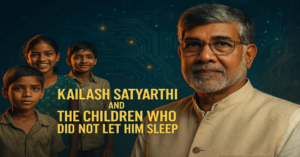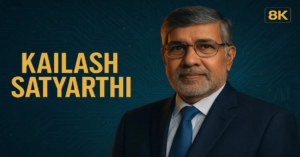Kailash Satyarthi: Nobel Laureate, Child Rights Crusader & Global Humanitarian
The Fire in His Bones: Kailash Satyarthi and the Children Who Wouldn’t Let Him Sleep

The rain in Vidisha wasn’t just water that day in 1959. It was a curtain, pulled back to reveal a truth too heavy for a five-year-old’s shoulders. Kailash Satyarthi, snug in his starched uniform, tilak fresh on his forehead, clutched his prized umbrella—a splash of color against the grey deluge. Ahead, a scene carved itself into his soul: a cobbler, his face twisted with a desperation that smelled like wet leather and despair, raining blows on his own shivering son.
The boy’s crime? Huddling under plastic to escape the downpour, letting customers’ shoes get ruined. “Roti ka sawal hai!” (It’s a question of survival!), the man sobbed, the sound raw against the drumming rain. In that instant, Kailash didn’t see poverty; he saw a monstrous equation: the value of leather > the life of a child. Without a word, a trembling hand thrust his cherished umbrella towards the crying boy, then turned and ran. It wasn’t kindness; it was rebellion. The first spark.
Becoming Kailash Satyarthi: Shedding Skin, Finding Soul
That dissonance hummed beneath his childhood. Asking “Why can’t he come to school?” earned a teacher’s sharp rebuke. The cobbler’s resigned sigh – “Hum toh kaam karne ke liye paida hue hain” (We are born to work) – was the bitter tea of caste destiny. But Kailash Sharma choked on it. At 11, he wasn’t playing football; he was funding revolution.
Every goal scored meant another child’s school fees paid. By 15, his “book bank” wasn’t just 2,000 dog-eared texts; it was an arsenal against ignorance, hauled door-to-door. Then came the shedding. Dropping “Sharma,” the high-caste armor, he embraced Satyarthi – “Seeker of Truth.” It felt less like a name, more like a tattoo on his spirit. A vow whispered in the face of a thousand resigned eyes.
The Blueprint He Burned: When Comfort Became Complicity
The engineering degree felt solid in his hand. The teaching job offered respect, security. But the ghosts wouldn’t leave. The image of that drenched boy bled into the comfortable lines of his blueprints. Gandhi’s words – satyagraha (truth-force), seva (service) – became a drumbeat in his chest, louder than societal approval. 1980. The year comfort died. He walked away. Family wept, neighbours scoffed: “Pagal ho gaya?” (Has he gone mad?). But Satyarthi knew: Real engineering wasn’t about wires; it was about cutting the chains binding millions of tiny wrists. His tools wouldn’t be calipers, but courage.
Bachpan Bachao Andolan: Raids, Rage, and the Ragged Sound of Freedom
-
Midnight’s Children:
Tip-offs came like secrets passed in the dark. Factories humming with illegal looms. Kilns where the air tasted of dust and despair. Brothels where innocence was a currency. The snap of bolt-cutters breaking chains wasn’t just sound; it was the ragged gasp of freedom. Children emerged blinking, skin papery-thin, eyes holding galaxies of stolen time. Some couldn’t remember their own names.
-
The Scars They Carried:
Activist Murari Sharma’s body, broken on a circus floor in 2004. Dhoom Das, silenced by a bullet. Satyarthi himself – bones broken by iron rods, nights spent listening for assassins’ footsteps outside his family’s hiding place. “Darr insaan ka sabse bada dushman hai,” he’d rasp. “Fear is humanity’s greatest enemy. We starve it.“
-
Bal Ashram: Where Broken Wings Learned to Fly:
Rescue was just chapter one. Bal Ashram was where chapter two began. Not just beds and rice, but psychologists gently untangling nightmares, teachers coaxing laughter from lips stiff with silence, artisans showing scarred hands how to create beauty. It smelled of hope, disinfectant, and fresh paint. Over 130,000 children passed through its gates, learning their first lesson: You belong to yourself.
Lighting Fires Around the World: Stubborn Hope on a Global Scale
-
Kailash Satyarthi: GoodWeave (1994):
He exposed the dirty secret knotted into India’s carpets: tiny fingers bleeding on intricate patterns. Instead of just shouting, he built. GoodWeave (first RugMark) – a label. Unannounced inspectors. If a loom was clean, the carpet got a tag. IKEA joined. Slowly, the tide turned – an 80% drop in South Asia’s carpet belt child labor. Not perfect, but proof: ethical shopping isn’t a trend; it’s a lifeline.
-
The Blistered March of Kailash Satyarthi (1998):
His masterstroke. Not a petition, but a Global March Against Child Labour. 80,000 km. 103 countries. Children marched who had never seen a playground. A boy missing an arm from a factory accident. A girl who escaped a brothel. Their blistered feet, their raw-throated chants, became an anthem the world couldn’t ignore. It hammered on the doors of Geneva until the ILO adopted Convention 182 (1999) – banning the worst child labour. The only convention every single nation on earth has ratified. The march made the invisible undeniable.
-
Kailash Satyarthi: 100 Million Campaign (2016):
Satyarthi looked at young faces and saw the future. The 100 Million Campaign wasn’t for youth; it was youth. Students in 35+ countries finding their voice, demanding freedom and safety for the 100 million still trapped. It was hope, loud and organized.
Oslo’s Echo: The Cobbler’s Son in the Hall of Kings

2014. Sharing the Nobel with Malala. The gold medal felt cold. The stage was his weapon. He didn’t start with numbers.
- He told them about the cobbler’s son in the rain.
- He spoke of Lakshmi, rescued from slavery, her spirit unbroken.
- “Child slavery is a crime against humanity,” his voice, usually calm, cracked with a fury honed over decades. “Humanity itself is at stake here.”
- He stared into the glittering audience: “How can the world remain so wealthy with its poor?” A silence thicker than velvet fell. It was a slap wrapped in truth.
India’s Agony: The Fight Beneath the Shine
- The Relentless Ticking: NCRB 2022: 18 crimes against children reported every hour. Over 10 million kids (5-14 yrs) still labouring. The world’s highest number. A crushing weight.
- Justice’s Hollow Shell: Good laws – Child Labour Act, POCSO. But enforcement? A sick joke. Corruption. Apathy. Underpaid, overwhelmed police. Only 32% of POCSO cases end in conviction. Rapists walk free while survivors wait lifetimes.
- Bharat Yatra: When His Feet Answered Fury (2017): Despair wasn’t an option. Satyarthi laced his boots. Bharat Yatra: 12,000 km. 22 states. 35 days. Millions marching, roaring against trafficking and abuse. The ground shook. It pushed through the 2018 POCSO amendment – death for raping children under 12. Controversial? Yes. But born from a nation’s scream he helped articulate.
The Kailash Satyarthi: Why He Still Walks at 70
160 million children globally are still enslaved. Conflict, climate chaos, and pandemic fallout push more into the shadows. Satyarthi’s fight evolves:
- The Digital Bog: He hounds governments and tech giants: “Hunt the predators on the dark web! Faster!” The digital chains are invisible but just as cruel.
- Supply Chains: The Devil’s in the Details: He demands corporations trace every thread, every mineral. “Who made your phone? Your chocolate? Look harder.”
- Healing the Unseen: Bal Ashram now has therapists specializing in the deep, silent scars. Trauma isn’t fixed with a roof and a meal.
- Climate’s Cruel Calculus: He connects the dots: droughts flood cities with desperate, vulnerable children – traffickers’ prey. Climate justice is child justice.
At Harvard, the old fire burned in his eyes: “My dream? Simple. A world where every child owns their childhood. Where their only chains are hugs. Where their days smell of chalk dust, grass stains, and pure, silly laughter. Until then? My feet keep moving. My voice won’t break.”
Kailash Satyarthi : A Legacy Written in Scars and Sparks
Kailash Satyarthi didn’t ask for charity; he demanded justice. He fused Gandhi’s fierce non-violence with the levers of global power and market forces. He proved one stubborn heart, fuelled by unbearable witness, can move mountains.
When asked about the beatings, the threats, the near-misses, a quiet, knowing smile often plays on his lips. He quotes the Mexican proverb like a shield: “They tried to bury us. They didn’t know we were seeds.”
Kailash Satyarthi: The Candle and the Covenant:
In his modest Delhi office, away from the medals and photos with world leaders, sits a simple, half-melted candle. Its story is the core of everything.
During a raid on a suffocating garment factory. His team pulled out children who hadn’t seen sunlight in months. As they stumbled into the light, one small boy, maybe eight, face etched with an old man’s weariness. Then he pressed something into Satyarthi’s hand. A candle stub, stolen from his captors.
“Kaka,” the boy whispered, the word rough from disuse, “woh log mujhe andhere mein rakhte the. Yeh lelo… meri raushni kar do.” (Uncle, they kept me in the dark. Take this… light my way home).
That stolen candle isn’t wax. It’s the covenant. Here it’s the unbreakable promise Satyarthi made – and keeps – with every child still waiting in the shadows. Then it’s the fragile, defiant flame he guards not just with his life. But with every ragged breath, every aching step, every roar against the dying of their light.
Because for Kailash Satyarthi, the truth he seeks is simple, searing, and non-negotiable: “Har Bachcha Hamara Bachcha Hai.” Every child is our child.
And for every one still lost in the dark, the Seeker of Truth is still walking, still searching, still holding that stolen light as high as his old, strong arms can lift it.